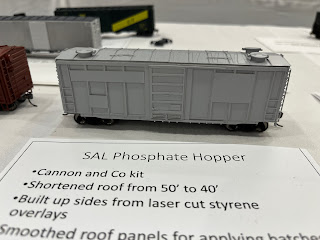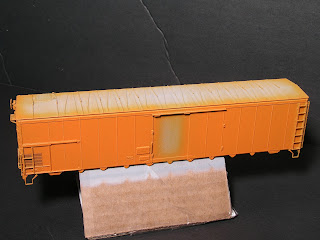Most recently, I decided to clean out several tubs and totes filled with project materials in hopes of sorting through several thousand detail parts, decal sheets, and under construction projects. Most of which I remembered building, but in my typical, "Look, Squirrel!!" brain, I often push it aside to model something a bit more interesting.
I've learned through the years, the enjoyment of the hobby for me is the teardown and rebuild process. Painting is usually the least of my favorite aspects of the hobby, but decaling is certainly one of my favorite aspects of prototype modeling.
In hopes of combating the ever growing list of under-construction projects, I decided to document the list so I have a record of sorts to determine the hierarchy of what to model.
SCL SDP35 616:
An Atlas rebuild with Cannon fans, new underframe details, ESU EMD 567D prime mover, speaker and LED installation.
SCL GP30 1320:
A Proto 2000 GP30 project still in the parts collection stage. The model was striped, grit blasted and is ready for detailing. The locomotive will be DCC equipped, and detailed with wire handrails, and SCL era appropriate details.
Seaboard Air Line #2 Depot:
Constructed as the Wimauma, Florida depot, this is a fun diversion from freight and locomotive projects, but I'm finally getting around to obtaining some parts which were never provided by the manufacturer. The current state of construction is stalled at window installation, and adding a stepped landing. The model is fully painted and awaiting these final details before the roof is sealed and added.
Fruit Grower's Express SAL 591181 RBL:
Still waiting on decals and completion. Such a fun kit to build, paint and construct, but shiny objects got in the way.
SFRP Rr-56 2106:
Almost across the finish line on this one with some final detail painting left to do. The weathering process and addition of appropriate trucks (Plate C Models, are you out there?!?!) is keeping this one just shy of the finished mark. The Rapido sound units must be made of unobtainium as I've not heard (see what I did there) a sound of them. Still a really fun project and the rebuild, repaint, and decaling process was thoroughly enjoyable.
PFE R70-20:
Part of the reefer block, this one has been fully built and is awaiting the application of black ends and is ready for decaling. This car has been one of the reasons I began building a reefer block in the first place, and again a great kit build.
Seaboard Air Line and Seaboard Coast Line 40' PS-1 Boxcars:
I constructed and have begun the weathering process of the SAL PS-1 in the 1964 Billboard Gothic scheme using the Kadee PS-1 model and it is all built completed. Meanwhile, the SCL PS-1 will be a beer service car which I recently located an excellent prototype photo to finally complete the research process. The SCL variation is painted, and in need of a gloss cote so that decaling can commence. Sadly, there is not an overabundance of photographic evidence of these 40' boxcars.
SCL K-19 Gondola:
This is a Tangent Scale Models parts build and is in the process of receiving decals at the moment. The car is fully constructed, painted and receiving a variety of SCL decals. Likely the closest project to completion given my current push.
SCL U36Bs:
A complete rebuild of the Atlas U36B underframe is in order, and the cab numerals have to be removed and reapplied given the "thinness" of the font used. Once upon a time, Atlas hit dingers when it came to SCL locomotives, but their artwork needs some resuscitation.
SCL RS-3 1155:
A complete Stewart and Atlas franken-Alco project. The model will utilize the Stewart hoods, sill, and an Atlas cab. The majority of the details will be sourced from KV Models as they have made construction of these workhorses easier.
SCL Split Image Alco S-2 and S-4 switchers:
Alco switchers have been a staple of my modeling for decades, and I love the looks and sounds of an Alco. The four of these switchers will be in various states of the Seaboard Air Line inspired black and red Alco switcher split image scheme, while others will find their way into the typical black and yellow Bumblebee paint scheme. Thankfully, Atlas retooled the cab windows to accurately model the later Alco S-4 cab appearance, so these should be a fun painting process.
SCL 5259 Pullman Plan 7600 52 seat coach:
What a project. I'm certain this is one of the longest builds of my model making career and I've lost, found, lost, and found again parts for this car. It is in pieces some of which were waiting for the proper shade of suede, deck tan, and silver. A majority of this car is done, but again squirrels found their way onto my work bench.
SCL 35 Split Image NW2:
If you have ever run a Kato locomotive, you well know that they are simply the best performing locomotives in our hobby. The model was converted to DCC after grinding the frame, and then the shell work began. The lowly switchers get sidelined the most, but it currently appears to be in a porcupine like state with all the various holes filled with styrene rod so that KV Model parts can be applied. The NW2 needs the most work of all my locomotive projects, so I truly need to dedicate some attention to this much needed prototype. It is fitted with a TCS Micro decoder and is in need of reassembly and final construction. I've lost count of how many times I found another example to model, and am waffling about the application of roller bearings to the side frames still. Finding an intact SCL NW2 with solid bearings is akin to finding a hen's tooth.
Seaboard Air Line and Seaboard Coast Line P-9 Phosphate Hoppers:
F&C kits abound throughout my collection in various states of construction. I need only 92 more of these to complete my endeavor, but I really need to consider some 3D printed details or etched ladders to make these as good as I want them to be. "Model Phosphate Trains, It will be Fun!" says the guy....
This is a short list of current projects, and in no way accounts for what other treasure I located such as fully re-constructed SW9s, DS4-4-1000s, SDP35s, GP40s, and many more. Beware of the squirrels, and in a year, I hope to have finally put some of these projects into the pages of the Seaboard-Coast Line Modeler.














































